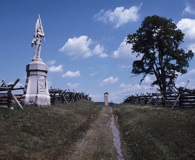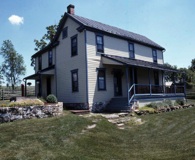Virtual Tour Antietam: The Civil War’s Bloodiest Day
 Tour Point 4 — The Samuel Mumma Farm: Continue the tour by moving south of the Dunkard Church, cutting eastward along the Smoketown Road, and advancing on the principal farmhouse in the center of the battlefield. Prominently located, this structure and its outbuildings burned during the battle after retreating Confederates set them ablaze to ward off Yankee sharpshooters. Only the Spring House is the original structure. Immediately northwest of the house lies the Mumma Cemetery, a plot that contains about 165 graves of local citizens. And about 500 yards southeast of the Mumma Farm stand two more prominent buildings fought around in the middle phase of the battle, the W. Roulette Farm and the Clipp Farm. As the Union troops advanced southward, Maj. Gen. Edwin V. Sumner’s II Corps pushed toward this area, with Maj. Gen. John Sedgwick in the lead. Heavy attacks met stiff Confederate resistance, resulting in hideous Union casualties. A second attack by Brig. Gen. William H. French resulted from a mistake when French led his division the wrong way and struck into the Confederates. French’s troops marched southward past the Roulette and Clipp farms, east of the Mumma Farm, which had been set ablaze by retreating Confederates early in the morning, and approached Daniel Harvey Hill’s Confederates, the northernmost of whom were lying down in the sunken road, transforming it into a trench.
Tour Point 4 — The Samuel Mumma Farm: Continue the tour by moving south of the Dunkard Church, cutting eastward along the Smoketown Road, and advancing on the principal farmhouse in the center of the battlefield. Prominently located, this structure and its outbuildings burned during the battle after retreating Confederates set them ablaze to ward off Yankee sharpshooters. Only the Spring House is the original structure. Immediately northwest of the house lies the Mumma Cemetery, a plot that contains about 165 graves of local citizens. And about 500 yards southeast of the Mumma Farm stand two more prominent buildings fought around in the middle phase of the battle, the W. Roulette Farm and the Clipp Farm. As the Union troops advanced southward, Maj. Gen. Edwin V. Sumner’s II Corps pushed toward this area, with Maj. Gen. John Sedgwick in the lead. Heavy attacks met stiff Confederate resistance, resulting in hideous Union casualties. A second attack by Brig. Gen. William H. French resulted from a mistake when French led his division the wrong way and struck into the Confederates. French’s troops marched southward past the Roulette and Clipp farms, east of the Mumma Farm, which had been set ablaze by retreating Confederates early in the morning, and approached Daniel Harvey Hill’s Confederates, the northernmost of whom were lying down in the sunken road, transforming it into a trench.
 Tour Point 5 — The Sunken Road: South of the Roulette and Clipp farms, this sunken farm lane epitomizes the slaughter at Antietam and was highly publicized because of famous photographs of dead lying within it. The images were taken by Alexander Gardner shortly after the battle and widely circulated, letting Americans see the horrors of war in real-world images for the first time (“Gardner has laid the dead of Antietam at our doorsteps” one commentator reported). Thus, it became the most infamous area of the battlefield. This little farm lane etched into the landscape, sunken by repeated use by wheeled carts, provided a natural rifle pit for Hill’s Confederates. The Rebels lay down inside the lane and fired to the north at the onrushing Yankees. The Federals pushed the Confederates out of the road, but only after fearsome casualties, which gave rise to the sobriquet “Bloody Lane.” The midday phase of the battle, concentrated on this area, lasted from about 9:30 a.m. to 1 p.m., and cost the Rebels more than 2,500 troops. Among the senior officers, Confederate Brig. Gen. George B. Anderson was mortally wounded in the Sunken Road, as was Union Brig. Gen. Israel B. Richardson. Today, the eastern end of the Sunken Road contains an observation tower built by the War Department in the 1890s in order to observe the field. From there you can see, to the southwest, the Henry Piper Farmhouse, another key position.
Tour Point 5 — The Sunken Road: South of the Roulette and Clipp farms, this sunken farm lane epitomizes the slaughter at Antietam and was highly publicized because of famous photographs of dead lying within it. The images were taken by Alexander Gardner shortly after the battle and widely circulated, letting Americans see the horrors of war in real-world images for the first time (“Gardner has laid the dead of Antietam at our doorsteps” one commentator reported). Thus, it became the most infamous area of the battlefield. This little farm lane etched into the landscape, sunken by repeated use by wheeled carts, provided a natural rifle pit for Hill’s Confederates. The Rebels lay down inside the lane and fired to the north at the onrushing Yankees. The Federals pushed the Confederates out of the road, but only after fearsome casualties, which gave rise to the sobriquet “Bloody Lane.” The midday phase of the battle, concentrated on this area, lasted from about 9:30 a.m. to 1 p.m., and cost the Rebels more than 2,500 troops. Among the senior officers, Confederate Brig. Gen. George B. Anderson was mortally wounded in the Sunken Road, as was Union Brig. Gen. Israel B. Richardson. Today, the eastern end of the Sunken Road contains an observation tower built by the War Department in the 1890s in order to observe the field. From there you can see, to the southwest, the Henry Piper Farmhouse, another key position.
 Tour Point 6 — The Henry Piper Farm: The Piper Farmhouse lies halfway between the edge of Sharpsburg and Bloody Lane. This group of buildings stands squarely in the thick of the early afternoon action and was used briefly for a council of war between Confederate Maj. Gens. James Longstreet, Daniel Harvey Hill, and Richard H. Anderson. The farmhouse, accessible from Dunkard Church Avenue, now serves as a bed-and-breakfast inn — the only historic structure where you can spend the night in the center of a Civil War battlefield. Late in the action along Bloody Lane, the Piper House figured prominently in the battle. As the Yankees swallowed up the lane, Hill became frantic. Desperate, Hill located Capt. M. B. Miller’s battery of the Washington Artillery, posted near the Piper Barn. Longstreet himself desperately directed the fire from this battery, which held off the Union surge. After a time, a caisson was directly hit and several gunners wounded; Longstreet and his staff themselves manned and fired the gun, Longstreet wearing carpet slippers over his chafed heel, which had been irritated by rough boots.
Tour Point 6 — The Henry Piper Farm: The Piper Farmhouse lies halfway between the edge of Sharpsburg and Bloody Lane. This group of buildings stands squarely in the thick of the early afternoon action and was used briefly for a council of war between Confederate Maj. Gens. James Longstreet, Daniel Harvey Hill, and Richard H. Anderson. The farmhouse, accessible from Dunkard Church Avenue, now serves as a bed-and-breakfast inn — the only historic structure where you can spend the night in the center of a Civil War battlefield. Late in the action along Bloody Lane, the Piper House figured prominently in the battle. As the Yankees swallowed up the lane, Hill became frantic. Desperate, Hill located Capt. M. B. Miller’s battery of the Washington Artillery, posted near the Piper Barn. Longstreet himself desperately directed the fire from this battery, which held off the Union surge. After a time, a caisson was directly hit and several gunners wounded; Longstreet and his staff themselves manned and fired the gun, Longstreet wearing carpet slippers over his chafed heel, which had been irritated by rough boots.
[continued on next page]
{default}

0 Comments
Trackbacks/Pingbacks